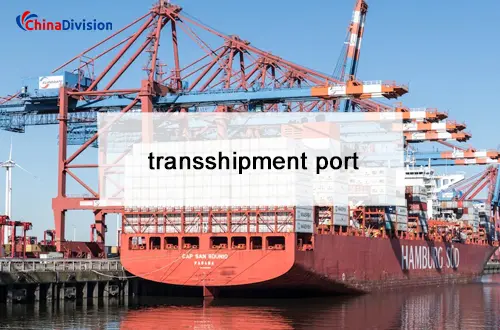How Do Transshipment Ports Impact Shipping Costs and Efficiency?
Transshipment ports are critical for optimizing supply chains and controlling costs. This process enables cargo to reach locations that are inaccessible to the original vessel, thereby optimizing shipping routes and reducing transportation costs for businesses. Whether you are a B2B business or an e-commerce seller, understanding the operating mechanisms of a transshipment port can help you improve logistics efficiency and mitigate operational risks.
Table of Contents
- What is a transshipment port?
- How to determine whether a transshipment port solution is necessary?
- Four Key Factors in Selecting a Transshipment Port
- Transshipment ports play a central role in international shipping.
- FAQs About Transshipment Ports
- Are you ready to simplify your international shipping?
In this blog, we will explore what a transshipment port is and why it is important, and delve into its core concepts, common problems, and solutions.
What is a transshipment port?
A transshipment port (also known as a port of transit, transit port, or transit place) is a port where cargo temporarily stops for loading, unloading, ship transfer, or a change of mode of transport en route from its port of origin to its port of destination. Unlike primary ports (ports where ships call directly to load and unload cargo without transshipment), transshipment ports are transit points along global trade routes.

These ports are not the final destination, but rather serve as strategic transit points to facilitate the flow of goods. Transshipment ports help overcome geographical, economic, or political barriers that hinder direct shipping. They provide flexibility, allow for cargo consolidation, and improve vessel utilization.
Key Terms Explained:
Transit Port/Transit Port: Similar to transshipment port—a temporary stopover for cargo before onward transportation.
Transshipment Point: A broader term that can refer to any location (not just ports) where cargo is temporarily stored or transferred.
International Transshipment Port: A transshipment port that facilitates global trade between multiple countries.
Common scenarios include:
No Direct Shipping Routes: No direct shipping routes between the origin and destination ports.
Cargo Consolidation/Splitting: Multiple small shipments are combined into a full container load (FCL), or a FCL load is split to multiple destinations.
Transportation Modal Switching: For example, sea to land, air to rail, etc.
Optimize costs and timeliness: Use transshipment ports to select faster or cheaper shipping routes.
Typical international transshipment ports include Singapore, Rotterdam, and Hong Kong, which serve as "hub ports" in the global logistics network.
How to determine whether a transshipment port solution is necessary?
The following situations are suitable for a transshipment solution:
There are no direct flights to the destination port;
Seeking lower freight rates (transshipment is generally cheaper than direct shipping);
Small cargo volumes requiring less-than-container-load (LCL) shipments.
Chinadivision can customize the optimal route based on your cargo type, budget, and timeliness requirements.
Four Key Factors in Selecting a Transshipment Port
1. Geographic Location and Route Coverage
Key Criteria: The transshipment port must be located at the intersection of major shipping routes (such as Singapore, which controls the Strait of Malacca), ensuring frequent ship calls and short transit times.
Data Reference: The world's top five transshipment ports (Singapore, Shanghai, Rotterdam, Busan, and Dubai) handle over 40% of global container transshipment volume.
2. Port Facilities and Loading and Unloading Efficiency
Hard Requirements: Deep-water berths (≥15 meters), automated terminals (such as Shanghai Yangshan Port), and intermodal transport connections (direct rail/road access).
Cost Traps: Some ports charge high "transit surcharges" (such as the THC fee at the Port of Rotterdam), which require advance accounting.
3. Policies and Compliance
Tax-free Policies: Free trade ports (such as Hong Kong) allow goods to be temporarily stored for 14 days duty-free, but the final destination of the goods must comply with the rules of origin.
Documentary Risks: Contracts must clearly indicate "W/T (With Transshipment)" or "VIA" to avoid disputes due to unclear terms.
4. Service Provider Capabilities and Network
Key Capabilities: Real-time cargo tracking, multi-port coordination, and emergency response (such as cargo detention and customs inspection).
Industry Pain Points: Small and medium-sized shippers are often forced to accept high-cost transit services due to lack of resources. For example, transit fees on African routes are often 30%-50% higher than direct routes.
Transshipment ports play a central role in international shipping.
1. Cost-Efficiency
Direct shipping to every destination is often impractical and costly. Transshipment ports allow carriers to consolidate cargo, reducing fuel costs and operating expenses.
2. Global Coverage
Many regions lack direct shipping routes. Optimizing route networks and consolidating cargo through transshipment ports can improve vessel load factors and reduce unit transportation costs. Transshipment ports provide access to remote markets by connecting smaller vessels to larger hubs. They also extend coverage, helping cargo reach destinations not directly served, making them particularly useful in emerging markets or remote regions.
3. Routing Flexibility
Flexibility in response to demand: When direct shipping routes are insufficient or capacity is tight, transshipment options can avoid delays. If direct routes are disrupted (for example, due to weather or geopolitical issues), transshipment ports can provide alternative routes to keep cargo moving.
4. Shorter Transit Times on Select Routes
While transshipment adds an additional stop, it can sometimes speed up shipping by leveraging an optimized hub-and-spoke network.
5. Managing Congestion
In the event of congestion at the final port, transshipment hubs can alleviate delays by offloading and transferring cargo via smaller vessels or other modes of transport.
6. Customs and Regulatory Advantages
Some transshipment ports have special customs areas that allow for faster processing of cargo, eliminating the need for full customs clearance and thus shortening delivery times.
FAQs About Transshipment Ports
How many transshipment ports does a shipment typically involve?
This depends on the route. Some shipments only need to go through one or two transshipment ports, while others may require more to reach a global destination.
Are transshipment ports the same as ports of destination?
A transshipment port is not the final destination. The "port of destination" is the official end point of the cargo's maritime journey. A transshipment port is merely a temporary stop along the way. Confusing the two can lead to significant delays and confusion.
Do transshipment ports increase transportation risks?
If you choose an experienced international transportation service provider like Chinadivision, these risks can be managed or even avoided. We provide systematic cargo tracking, customs clearance assistance, and coordination with ports to ensure safe and efficient transit of cargo at transshipment ports.
Are transshipment ports more expensive?
Not necessarily. They typically reduce overall costs through bulk shipments and efficient routes.
What are the world's busiest transshipment ports?
Major hubs include Singapore, Shanghai, Rotterdam, and Dubai, handling millions of TEUs annually.
Do transshipment ports increase shipping times?
Not necessarily. Some transshipment routes can actually be faster than direct routes, especially when direct routes are scarce or shipping capacity is limited. Chinadivision intelligently recommends the optimal route based on your cargo type and destination.
Are you ready to simplify your international shipping?
Transshipment ports are an essential component of international logistics, and their proper use can significantly enhance supply chain resilience. Whether you face route restrictions, cost pressures, or timeliness challenges, Chinadivision can provide professional services to help you resolve your challenges.
Whether you're an e-commerce startup or a large wholesaler, Chinadivision can tailor international shipping solutions to help you reach global markets. Visit our website or contact our logistics consultants directly for a free shipping assessment and quote.





